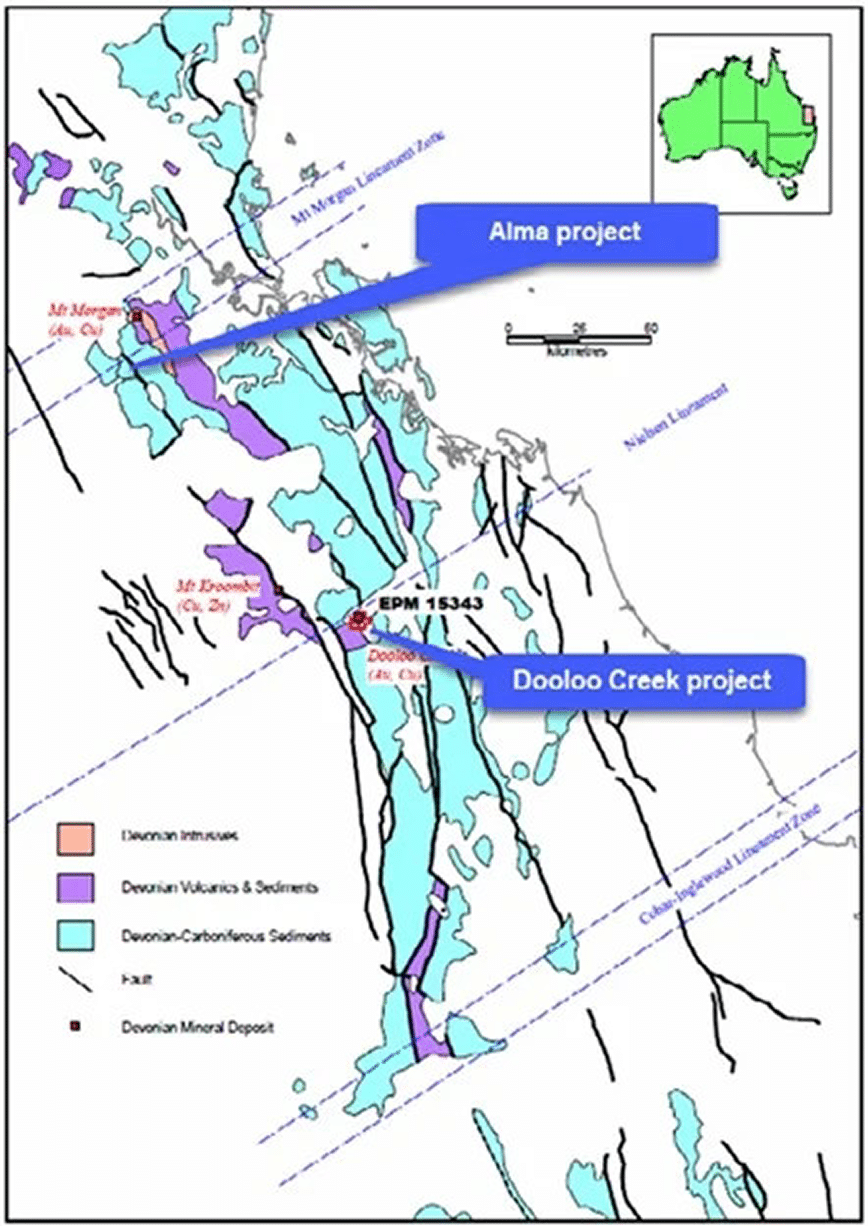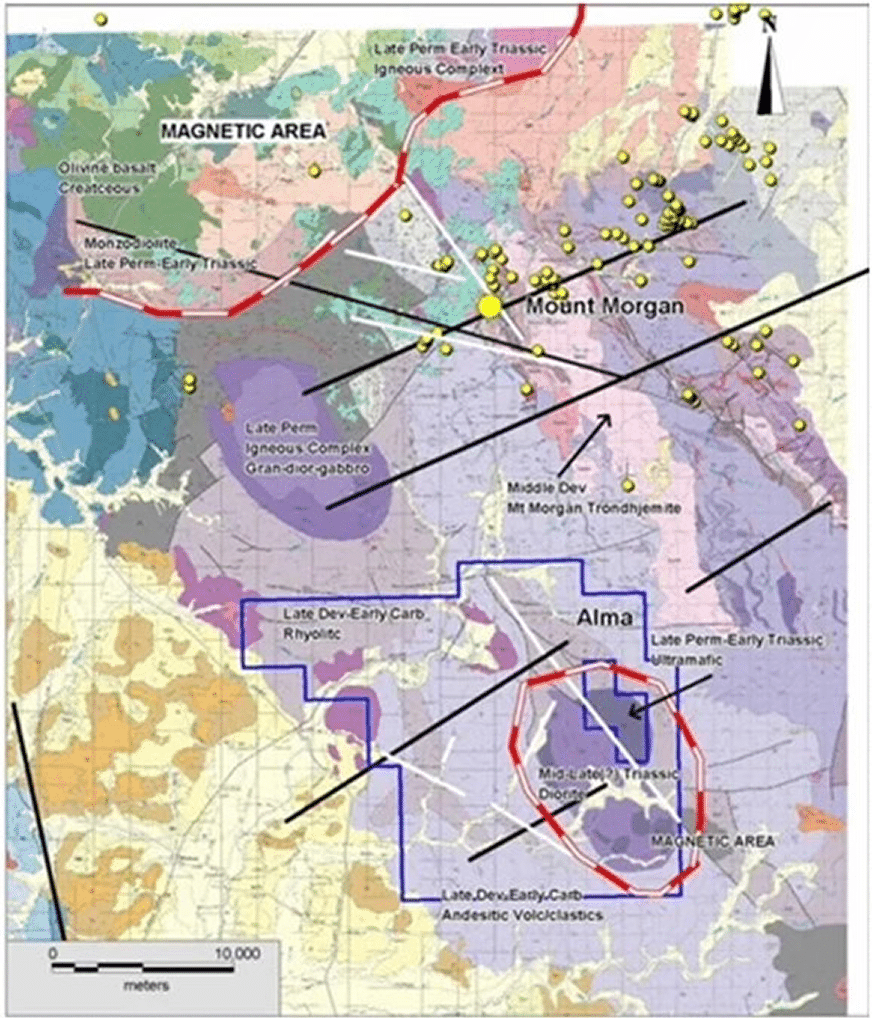Alma, Queensland
Project

History
The Alma project (EPM 27722) is located approximately 670km by road northwest of Brisbane. Mount Morgan town is 15km north of the project and has a population of ~2,000 people as at the June 2016 census. The economy of the region is agriculture based, consisting primarily of cattle and minor crop farming. The figure on the right summarises the access to the Alma and Dooloo Creek projects.
Mount Morgan was the largest single lode gold ore body in Australia and the Mount Morgan region represents Australia’s fourth largest gold producing area.
The Mt Morgan region has had a long focus of exploration since the discovery of alluvial gold in Gavial Creek, in 1865. Since then, the Mt Morgan deposit was discovered in 1882, which was initially exploited for gold then for both gold and copper from 1902. Subsequent explorers focused on the south-east trending Mt Morgan Mine Corridor in hopes of discovering another deposit similar to it. This work primarily included regional mapping, magnetic surveys, electrical surveys, stream sediment sampling, follow up soil sampling and very limited drilling.
The Company are yet to undertake substantial exploration on the tenement however all indications suggest that the Alma project has high prospectivity potential.

Regional Geology and Mineralisation
The Alma Project is in southeast Queensland within the New England Orogen. The regional geology consists of a package of Devonian to Carboniferous sedimentary rocks that is cut by late Devonian magmatic and volcanic activity. The resulting island arc setting has been termed the Calliope Arc, and it strikes north-northwest for more than 500km (see figure below). The Devonian arc is subsequently cut by a Triassic aged magmatic event that is often related to thoroughgoing northeast trending structures. Cretaceous aged magmatism has also been noted in the region, and younger Tertiary aged basalts cover the older rocks in some areas.
Both the Alma and Dooloo Creek projects are located along the same geological sequence as the Mount Morgan mine. Alma sits within the Mount Morgan lineament as shown in the figure below. The main metallogenic events in the area are associated with Devonian Triassic granite plutons located along the Nielsen lineament and Devonian to Triassic intrusives, ranging from tonalite to diorite and ultramafic compositions. These plutons intrude Devonian and Carboniferous volcanic rocks and calcareous sediments.
The Devonian to Carboniferous sediments include clastic rocks, such as lithic and feldspathic arenite, conglomerate, siltstone, mudstone, and shale, and there are also carbonate sequences including oolitic and crinoidal limestone. These are generally grouped into the upper Devonian – lower Carboniferous Three Moon Conglomerate and the overlying Rockhampton Group. The late Devonian (Carboniferous) volcanic rocks are comprised of felsic to mafic lavas, tuffs, and volcaniclastics. The Triassic magmatism resulted in intermediate to mafic lavas and ignimbrites, which are mapped as the Dooloo Tops volcanics.

Local Geology & Mineralisation
The historic Mount Morgan Mine, 15km north of Alma, is situated in the north-west trending Calliope Volcanic Arc within the Tasman Orogenic zone. The Calliope Volcanic Arc is comprised of the Capella Creek, Mt Holly and Barmundoo Formations, which are predominantly composed of shallow marine limestone and volcaniclastics with minor volcanic flows. The Alma project occupies the next major lineament to the south of the Mt. Morgan complex.
The project area is predominantly covered by farmland with limited outcrop observed to date. Interpreted geology, mainly from airborne geophysics, identifies a possible diorite intrusive surrounded by andesitic volcanics. More felsic volcanics are also interpreted in the northern project area. The figure below shows the project geology along with the known copper and gold mineralisation (shown as yellow points). The Alma project has had limited exploration completed and there has been no drilling to date. Expected mineralisation would be related to the Mount Morgan model, but additional work is required, and the Company will aim to develop a working exploration model.
A favoured model for the genesis of the world class Mount Morgan deposit is a mid- to late Devonian igneous-related replacement orebody. Arnold & Sillitoe (1989) favour this intrusive-related replacement model for Mt Morgan as this explains why the Upper Mine pyroclastics at Mt Morgan were mineralised. If it were a volcanogenic massive sulphide (VMS) deposit (a competing theory), then the pyroclastic rocks would not be mineralised. The limited exploration that has been conducted in the vicinity of the Alma project was focused on gold, silver, and copper. The area includes a significant magnetic high, with numerous potential targets reflected as magnetic lows. Based on the Mt. Morgan model, much of the historic exploration was centred on the interpreted intrusive complexes.
Prospectivity
The Alma project has had no reported exploration work completed in the last 10+ years. However, stream sediment sampling by Central Pacific Minerals Ltd and Geopeko identified several gold prospects and a large copper anomaly that have seen very limited follow-up exploration activity. Goldfields collected rock samples from some of the gold prospects and generated multiple copper values above 1.0%, as well as some significant gold-silver anomalies. It is evident that the Alma project area hosts an igneous – volcanic complex of Devonian to Triassic age with quartz veins, breccia, and extensive alteration noted by previous workers.
Based on a limited review of the geology and alteration described in the samples plus the multielement geochemistry of the samples, it is reasonable to conclude the area is prospective for a spectrum of mineral systems including porphyry copper gold, epithermal veins, intrusion related gold, and possibly Mt. Morgan type gold copper. The property is at a very early stage of exploration and encompasses a huge area (>294km2). The Alma project should therefore be considered highly prospective but in need of extensive exploration work to realise that potential.
The Company proposes to commence field work and early-stage exploration in the later part of 2025.
